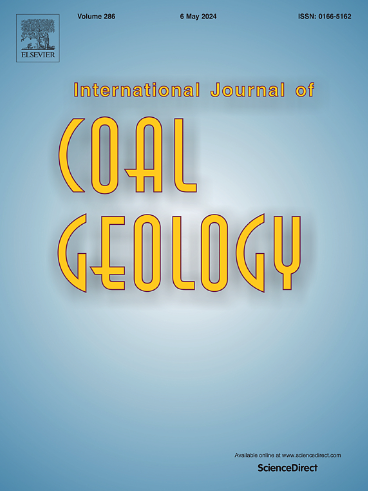莫桑比克马普塔兰沿海平原间泥炭形成环境的演化
IF 5.7
2区 工程技术
Q2 ENERGY & FUELS
引用次数: 0
摘要
在莫桑比克马普塔兰的大象狩猎保护区(EGR),沙丘之间已经开发了几个小泥炭地。研究的目的是确定泥炭地的形成条件,阐明泥炭地的演变。沼泽表面生长着草本植物(芦苇和莎草)。在EGR的几个位置,从9个人工检索的岩心中采集了55个有机和无机样品,深度达4.4米。有机沉积物的最大厚度为2.5 m。进行的测定包括近似和最终分析,pH值和电导率(eC)测量,有机岩石学检查,以及分别应用x射线衍射和x射线荧光光谱的矿物学和地球化学分析。泥炭样品的灰分为10.1 ~ 46.8%(干基),硫含量高达8.9% (db), pH值为2 ~ 7.3 μS/cm, eC值为142 ~ 2360 μS/cm。泥炭中主要矿物为石英、钾长石和黄铁矿;因此,二氧化硅是主要元素,铁、铝、钙和镁是次要元素。泥炭的矿物组成以腐殖岩组为主(57.6 ~ 78.6%,无矿物基础),其次为惰质组(13.8 ~ 38.2 vol%)和脂质组(9.6% vol%)。腐殖石亚群,特别是腐殖石亚群,以及腐殖石亚群的普遍存在,表明植物残骸发生了剧烈的机械分解,当地地下水位因随后的火灾而周期性下降,在此期间,泥沼表面暴露于氧化。总的来说,泥炭积累发生在流变到中营养条件下。本文章由计算机程序翻译,如有差异,请以英文原文为准。
The evolution of interdunal peat-forming environments in the Maputaland coastal plain, Mozambique
In the Elephant Game Reserve (EGR) in Mozambiquan Maputaland, several small peatlands have been developed between dunes. The aim of the study is to determine the peat-forming conditions and elucidate the evolution of the peatlands. Herbaceous vegetation (reeds and sedges) thrive on the surface of the mires. Fifty-five organic and inorganic samples were picked up from nine manually-retrieved cores up to 4.4 m deep, across several locations in the EGR. The maximum thickness of the organic sediments is 2.5 m. The determinations performed included proximate and ultimate analyses, pH and electrical Conductivity (eC) measurements, organic-petrography examination, as well as mineralogical and geochemical analyses applying X-ray diffraction and X-ray fluorescence spectrometry, respectively. The peat samples display ash yields between 10.1 and 46.8 % (on dry basis), sulphur content up to 8.9 % (db), pH and eC values from 2-7.3 and 142–2360 μS/cm, respectively. Quartz, K-feldspars and pyrite are the major minerals contained in peat; accordingly, silica is the major element with iron, aluminum, calcium and magnesium being minors. The maceral composition of peat reveals the predominance of the huminite group (57.6–78.6 vol%, on mineral matter-free basis), followed by inertinite (13.8–38.2 vol%) and liptinite (<9.6 vol%). The prevalence of the detrohuminite subgroup, particularly of attrinite, along with inertodetrinite, points to intense mechanical decomposition of the plant remains and periodical lowering of the local watertable with subsequent fires, during which the mire surface was exposed to oxidation. Overall, peat accumulation took place under rheo- to mesotrophic conditions.
求助全文
通过发布文献求助,成功后即可免费获取论文全文。
去求助
来源期刊

International Journal of Coal Geology
工程技术-地球科学综合
CiteScore
11.00
自引率
14.30%
发文量
145
审稿时长
38 days
期刊介绍:
The International Journal of Coal Geology deals with fundamental and applied aspects of the geology and petrology of coal, oil/gas source rocks and shale gas resources. The journal aims to advance the exploration, exploitation and utilization of these resources, and to stimulate environmental awareness as well as advancement of engineering for effective resource management.
 求助内容:
求助内容: 应助结果提醒方式:
应助结果提醒方式:


